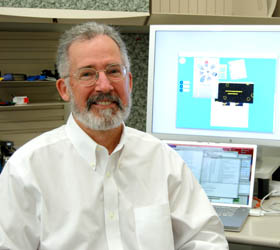Dan Ingalls, Architect of Smalltalk, Lively Kernel and member of SAP's Chief Scientist Team
 I've always felt that Web programming was more complicated than it
needed to be. I look at Web pages and go, 'Whoa! This doesn't look like
what I would normally do.'
I've always felt that Web programming was more complicated than it
needed to be. I look at Web pages and go, 'Whoa! This doesn't look like
what I would normally do.'
Dan Ingalls is passionate about making computing simple, concrete and fun. To achieve that he advocates use of flexible dynamic systems that can eventually be locked down instead of building static systems and then try to add dynamic features.
”My philosophy has always been: Make it first dynamic and malleable and then you can always turn off those capabilities. But you're in much less of a position to go forward in the world if you start out with stuff that can't be changed,” he said in a ”Contrarian Minds”-article.
During his more than 40 year long career in IT, he has become most famous for building Smalltalk together with Alan Kay. Starting with the first implementation of Smalltalk, written in BASIC and based on one page of notes from Alan Kay, Dan Ingalls has been involved in implementing several generations of Smalltalk. From the first prototype to the present-day open source implementation, Squeak.
Dan Ingalls started his career a long time ago before the web caught on, but now he is using his experience and skills to make web programming easier and more intuitive. In 2006 he started the open source project Lively Kernel with colleagues from Sun.
Lively Kernel is indeed a dynamic and malleable environment built entirely in JavaScript. No need for plugins.
You can not only display graphics but manipulate them and create new ones on the fly. You can examine the source code and change it on the fly as well. In short, the Lively Kernel can be used as an integrated development environment.
”It seemed to us that if you began with a dynamic language and structured graphics, like desktop systems of the 1980s, then even Web-based applications could be just as lively and interactive as the best desktop software," Dan Ingalls explained in the Contrarian Minds-article.
When Dan Ingalls worked for Xerox Parc in the 1970's among other things
he invented the BitBlt operation used in bit-mapped graphics. He coded
it in microcode for PARC’s Alto computer, allowing the high-performance
bit-mapped graphics that enabled him to make UI-innovations such as
pop-up menus that we now all take for granted.
Dan Ingalls' full name is Daniel Henry Holmes Ingalls, Jr. after his
father Daniel H.H Ingalls Sr. who once stayed in Germany. “H H” is
pronounced in German as ha-ha.
“My father must have liked it, because he made me a junior after his stay in Germany,” Dan Ingalls told Leo Laporte in a FLOSS Weekly-podcast.
“My father must have liked it, because he made me a junior after his stay in Germany,” Dan Ingalls told Leo Laporte in a FLOSS Weekly-podcast.
Dan Ingalls received the Association for Computing Machinery Grace Murray Hopper Award in 1984 and the ACM Software System Award in 1987 for his work on Smalltalk. In 2002 he won the Dr. Dobb’s Excellence in Programming Award.
Links:
